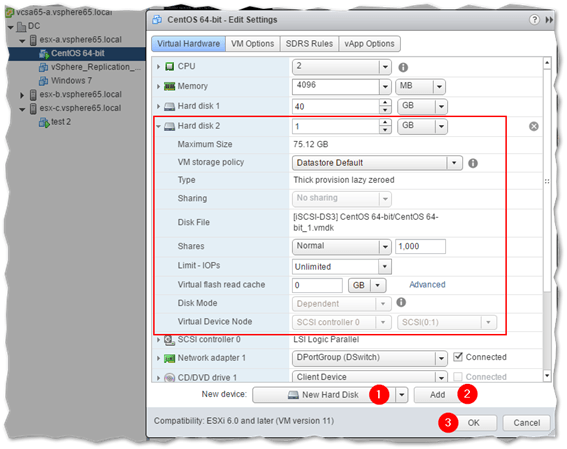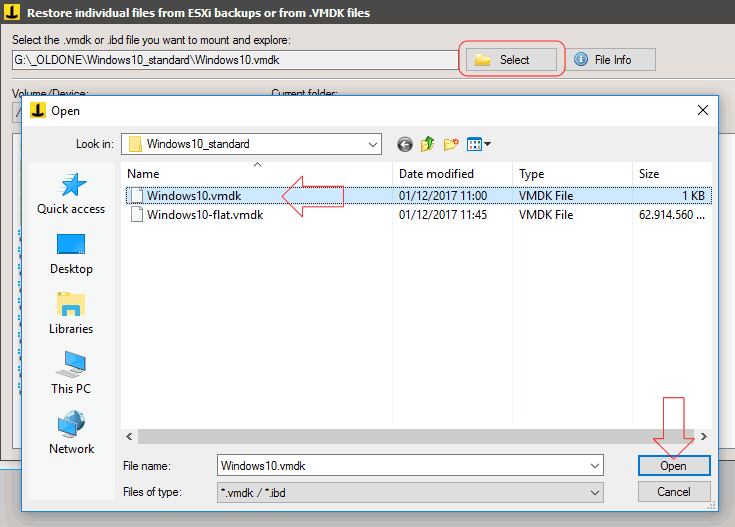From the list select Virtual Disk Map. See the volume consists of 2 files.

How To Manage Disk Space On Vmware Linux Virtual Machines
LVM has a collection of tools for displaying information about logical volumes.

. First open the Disk Management console diskmgmtmsc in Windows. Selected product version. Using this method is very predictable and safe but depending on the size of the volume might require a sizable maintenance window as you convert the volumes.
0x000da525 Device Boot Start End Sectors Size Id Type. In VM OS Create Partition 3. Guestmount -a guestimg -i -.
So assign the drive letter I use Z. Du command Display the amount of disk space used by the specified files and for each subdirectory. Now we have the thin provisioned clone we may want to delete the original virtual disk.
To find correct corresponding disk against your device in UNIXLinux server you can follow below steps. Then unmount the VMDK image file from the Linux file system when not in use. If the disk you want to remove is used by the filesystem then you will have to un-mount it first.
Sdb Attached SCSI disk. The size of the vmdk disk is shown in the Extent description section. Check its sector size.
Here and type v2 to mount that volume. Vgextend VolGroup00 devsda3 Volume group VolGroup00 successfully extended. Btrfs fi df device Show disk space usage information for a btrfs based mount pointfile system.
Dmesg is the easiest way to map the disk with vmdk files. Use the vmkfstools command to check or repair a virtual disk if it gets corrupted. 512 bytes 512 bytes Disklabel type.
Click on File and Select Map Virtual Disks. Use below command to perform this task. Add physical volumes to a volume group using vgextend.
Group1 mnt vmdk Now select the target directory and check the Mount read-only checkbox. To get libguestfs to detect guest mountpoints for you. Heres how to do it.
Steps to Remove VMDK disk from Virtual LinuxUnix Server. Dd ifdisk-with-i-o-errors-flatvmdk offixed-disk-flatvmdk bs1M If that works without errors you can regard fixed-disk-flatvmdk as healthy. Install a full pack of 7-zip on your Linux machine.
Solution 1- Using VMware Firstly open your VMware Workstation. Step 3 - B rowse to the folder that contains the VMDK files and then. This will list the paritions inside the vmdk so you would know what partition number to choose.
It allows the ability to convert the in guest volumes to a native VMDK files. Next run the utility with the p option and specify the path to the VMDK file CtempWin2008Servvmdk in my case. If that again fails with IO errors you probably have VMFS heartbeat corruption on that volume.
The lvscan option as the other LVM elements scans the system and provides minimum information on the logical volumes. Sectors of 1 512 512 bytes Sector size logicalphysical. Reboot the VM 4.
Df command Shows the amount of disk space used and available on Linux file systems. We can see the device port for VMWare Virtual disk SCSI Disk. The steps to follow are given below.
The commands that you need. Step 1 - Install and launch Linux Reader on your PC. Dmesg grep -i Attached SCSI disk sample outout.
Sda Attached SCSI disk. Windows Explorer should help you with this. Now find out how your Volume Group is called.
This is done by running vmkfstools -U test2vmdk. 7z l mediauser1vmsWinXP-testWinXP-testvmdk grep boot. The lvreduce command can be used to reduce the size of a logical volume.
Obviously you need the larger one the second one in my case. Check Disk Space in Linux With du Command The du command displays disk usage. Lets extend that Volume Group by adding the newly created physical volume to it.
Try from esxi-shell or ssh. Step 2 - Click DriversMount Image and tap the Container radio button. 20 GiB 21474836480 bytes 41943040 sectors Units.
First of all take output of fdisk command and save it. The next important step is to unmount the filesystem. Fdisk -l tee tmpfdisk-preout.
Vgdisplay--- Volume group --- VG Name VolGroup00. Execute the affixed command as. Increase A VMware Disk Size VMDK Formatted As Linux LVM 2.
Group1 mnt vmdk chown -R user1. Lets find the files that contain boot in their names for instance. Execute the following command on your linux.
Now you need to open the folder with the VMDK file using the right mouse button. You can try to mount VMDK on Windows using built-in tools. How to open VMDK files with 7-zip on Linux.
Sde Attached SCSI disk. Guestmount -a linuximg -m devVGLV -m devsda1boot --ro mnt. This can be achieved with the help of ls command or lsscsi command.
Here you can browse towards the location of your VMDK virtual disk file and verify the volume size. Right-click Start and select Explore. Fdisk -l mntvmdkfilevmdkraw example Disk filevmdkraw.
Sdg Attached SCSI disk. Ubuntu is used in this example. The SCSI controller name and SCSI device number are not displayed in the list of disks.
To reduce the VMDK disk from 80 to 40 GB we have to specify 83886080 in the Extent description section. Then select VMware virtual disks. We display the contents of the virtual disk configuration file vmdk using the cat command.
Use Windows Explorer to mount VMDK disk. Pvcreate devsda3 Physical volume devsda3 successfully created. Finding Correct Corresponding VMDK in LinuxUNIX.
Conversion using the VMware converter This method using the VMware converter tool installed in the VM. Vmware-mount pathtovmdk partition. If that works without vmkfstools-errors you can regard fixed-diskvmdk as healthy.
Delete a Virtual Disk using vmkfstools. Vgextend allows you to add one or more initialized physical. First we need to find SCSI controller number and target number from server side.
Linux commands to check disk space using. Open mnt vmdk directory in Linux explorer and browse the files on the VMDK virtual disk. Set the new size of the virtual disk using a text editor.
There are eight8 functional steps to resize the logical volume in linux. When deleting virtual disks from the cli it is recommended to use vmkfstools rather than the linux rm command purely because vmkfstools deletes both the virtual disk file and its descriptor. -x--fix checkrepair For example vmkfstools -x check.
For a typical Linux guest which has a boot filesystem on the first partition and the root filesystem on a logical volume. Test-volume This VMDK volume must already exist. List contents of the vmdk file with 7zip.
Then to get the SCSI device number we can right-click a disk and select Properties. Sdd Attached SCSI disk. Creates the physical volumes using pvcreate 6.
This tool can display disk usage for individual directories in Linux giving you a finer-grained view of your disk usage. 512 bytes 512 bytes IO size minimumoptimal. Format the new partition 5.
How To Preview Recovered Vmdk File Before Purchase

Mount C Esxi Vmdk Virtual Disks In A Linux Server Granular Recovery

How To Mount And Open A Vmdk And Extract Files With Iperius Free
0 Comments